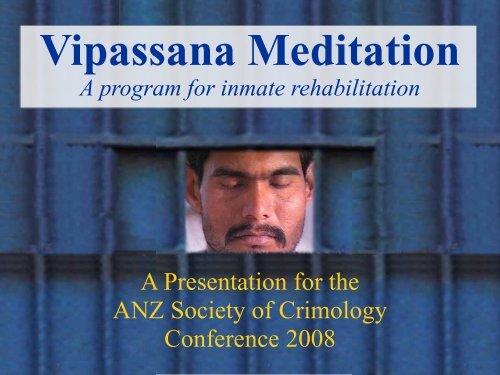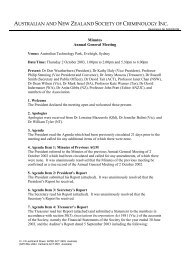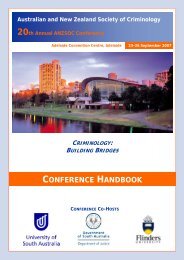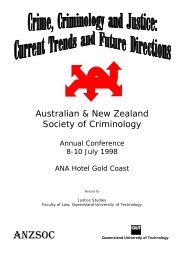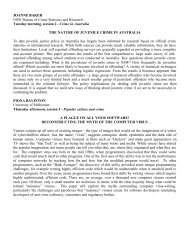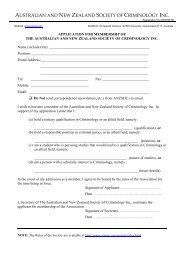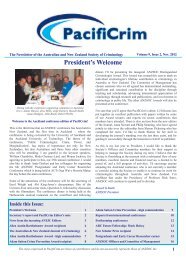Vipassana Meditation - Australian and New Zealand Society of ...
Vipassana Meditation - Australian and New Zealand Society of ...
Vipassana Meditation - Australian and New Zealand Society of ...
You also want an ePaper? Increase the reach of your titles
YUMPU automatically turns print PDFs into web optimized ePapers that Google loves.
<strong>Vipassana</strong> <strong>Meditation</strong><br />
A program for inmate rehabilitation<br />
A Presentation for the<br />
ANZ <strong>Society</strong> <strong>of</strong> Crimology<br />
Conference 2008
What is <strong>Vipassana</strong>?<br />
● The word <strong>Vipassana</strong> means “insight” or “to see<br />
things as they really are”<br />
● It is a universal, scientific, non-sectarian <strong>and</strong><br />
results-oriented technique <strong>of</strong> meditation<br />
● A systematic process <strong>of</strong> ethical <strong>and</strong> mental<br />
training in which sustained self-observation<br />
leads to increased awareness, self-control <strong>and</strong><br />
inner balance<br />
● An effective way to bring about real, meaningful<br />
change <strong>and</strong> to lead a balanced, happy life
The essence <strong>of</strong> <strong>Vipassana</strong><br />
<strong>Vipassana</strong> works on the<br />
premise that all suffering, <strong>and</strong><br />
therefore the cause <strong>of</strong> all crime,<br />
begins within
<strong>Vipassana</strong>: risk/needs matching<br />
<strong>and</strong> responsivity<br />
● Offenders, especially high-risk <strong>of</strong>fenders,<br />
<strong>of</strong>ten work the hardest <strong>and</strong> demonstrate the<br />
highest responsivity to the <strong>Vipassana</strong> course<br />
because <strong>of</strong> their intense experience <strong>of</strong> suffering<br />
as a result <strong>of</strong> their underlying crime, state <strong>of</strong><br />
mind <strong>and</strong> period <strong>of</strong> incarceration
<strong>Vipassana</strong>: risk/needs matching<br />
<strong>and</strong> responsivity<br />
● <strong>Vipassana</strong> is ideal for most <strong>of</strong>fenders, including<br />
<strong>and</strong> especially high-risk, high needs <strong>of</strong>fenders<br />
● It works directly with the ultimate underlying<br />
cause <strong>of</strong> high-risk <strong>of</strong>fences such as violence,<br />
sex <strong>and</strong> drug-related <strong>of</strong>fences<br />
● It works directly with the ultimate underlying<br />
cause <strong>of</strong> drug <strong>and</strong> alcohol addiction<br />
● It works directly with the ultimate underlying<br />
cause <strong>of</strong> other repeat-<strong>of</strong>fences such as theft<br />
<strong>and</strong> robbery
Criminogenic needs:<br />
why <strong>Vipassana</strong> is so effective<br />
● Traditionally recognised criminogenic needs are<br />
only superficial consequesces <strong>of</strong> a deeper set <strong>of</strong> mental<br />
phenomenon, not the underlying cause <strong>of</strong> crime<br />
● Crime <strong>and</strong> other immoral actions ultimately occur<br />
because <strong>of</strong> deep mental cravings <strong>and</strong> aversions: i.e.<br />
reactions occuring within the subconscious mind<br />
● <strong>Vipassana</strong> works at the depth <strong>of</strong> the subconsious<br />
mind, by retraining the mind not to react <strong>and</strong> also by<br />
removing old mental reactions from the past<br />
● This process brings about real, lasting change in<br />
awareness, attitude, responsibility <strong>and</strong> behavior
Criminogenic needs:<br />
why <strong>Vipassana</strong> is so effective<br />
Mr S. N. Goenka<br />
Founding Teacher
The <strong>Vipassana</strong> course is unique:<br />
● Ten continuous days <strong>of</strong> meditation, segregated from<br />
other inmates for the complete duration <strong>of</strong> the course<br />
● A disciplined timetable <strong>of</strong> 10 to 11 hours<br />
meditation each day from 4.30am to 9pm<br />
● No reading, writing, music, radio, television,<br />
no sense pleasures; no contact with the outside world<br />
● No talking or communicating with fellow inmates<br />
(they may talk to the teacher if necessary)<br />
● Voluntary only<br />
● There is no cost for the <strong>Vipassana</strong> prison course:
The <strong>Vipassana</strong> course is unique:<br />
All <strong>Vipassana</strong> courses are held free <strong>of</strong> charge.<br />
The teacher, the course manager or others serving on<br />
the course or assisting prison staff to organise the<br />
course do not receive any form <strong>of</strong> remuneration
Dispelling myths<br />
● There are many forms <strong>of</strong> meditation. <strong>Vipassana</strong><br />
works directly with deep mental reactions<br />
by retraining the mind not to react according to very<br />
old habit patterns<br />
● <strong>Vipassana</strong> does NOT involve imagination<br />
● It is NOT a relaxation technique<br />
● It is definitely NOT a holiday from regular prison life<br />
● The <strong>Vipassana</strong> course is a very intense <strong>and</strong><br />
challenging experience<br />
● Inmates who undertake the course must be<br />
very committed <strong>and</strong> determined
Dispelling myths
History <strong>of</strong> <strong>Vipassana</strong> in prisons<br />
● 1975: First prison course conducted at the Jaipur<br />
Central Jail in India, for 120 inmates<br />
● 1993: first course for 96 inmates in Tihar prison, the<br />
largest prison in India with more than 10,000 inmates<br />
● 1994: a course for 1,004<br />
inmates at Tihar prison<br />
● Since then two 10-day courses held at Tihar each<br />
month<br />
● Around 80 <strong>Vipassana</strong> courses are held each year in<br />
Indian prisons.
Prison courses in North America<br />
● 1997: First course at the North Rehabilitation<br />
Facility (NRF), near Seattle. Twenty <strong>Vipassana</strong><br />
courses were held at NRF over five years<br />
● 2001: San Bruno Prison, San Francisco<br />
● Jan 2002: The first course in a (Level 6) maximum<br />
security state prison in the US was held at the<br />
W.E. Donaldson Prison for 20 inmates<br />
● May 2002: Second course at Donaldson for 18 inmates<br />
● 2005: the first course in a federal prison, the Federal<br />
Medical Center (FMC), Devens, for 18 inmates
● January 2006: W.E. Donaldson Prison began an ongoing<br />
program <strong>of</strong> <strong>Vipassana</strong> courses implementing two 10-day<br />
courses a year<br />
● May 2006: Hamilton Aged <strong>and</strong> Infirmed Correctional<br />
Facility, a medium-security state prison in northern<br />
Alabama, inaugurates an ongoing <strong>Vipassana</strong> program<br />
twice a year<br />
● The Alabama Dept <strong>of</strong> Corrections is also looking to<br />
implement <strong>Vipassana</strong> programs into a women's<br />
correctional facility in the near future
“The Dhamma Brothers”<br />
A documentary about inmates<br />
who undertake the<br />
<strong>Vipassana</strong> course<br />
at the Donaldson Prison<br />
in Alabama
Other prison courses worldwide<br />
● Lancaster Prison, United Kingdom<br />
● Te Ihi Tu Rehabilitation Centre, <strong>New</strong> Zeal<strong>and</strong><br />
● CPB Prison, Spain<br />
● Courses have also been held worldwide in<br />
Israel, India, Thail<strong>and</strong>, Taiwan, Mexico,<br />
Argentina <strong>and</strong> Mongolia
Research Findings: India<br />
Research on inmate populations in India<br />
indicates that <strong>Vipassana</strong> meditation results in:<br />
● Increased positive behaviour / significant<br />
reduction in hostility <strong>and</strong> anger<br />
● Increased cooperation with prison authorities<br />
● Reduced psychological symptoms<br />
● Reduced recidivism<br />
● Inmates admitting to their crime, willing for reparation<br />
The government <strong>of</strong> India has formally recommended<br />
<strong>Vipassana</strong> courses as a rehabilitative treatment<br />
program to all <strong>of</strong> its jails <strong>and</strong> prisons.
Research Findings:<br />
USA<br />
North Rehabilitation Facility (NRF)<br />
● Minimum-security detention facility specializing<br />
in substance abuse recovery.<br />
● NRF’s population consisted largely <strong>of</strong> chronic<br />
re-<strong>of</strong>fenders (about 75% were returnees).<br />
At the experiential level, addiction is a deeply felt<br />
craving – not for a substance but for the sensations<br />
associated with the substance (i.e. how it feels).<br />
<strong>Vipassana</strong> works by training one's mind to observe the<br />
link between sensation <strong>and</strong> craving <strong>and</strong>, rather than<br />
reacting to it, learning to diminish it progressively.
Research Findings:<br />
USA<br />
● Two major studies were conducted on post-course<br />
inmates at NRF:<br />
● a four-year internal study <strong>and</strong> evaluation that<br />
focused on recidivism. The results <strong>of</strong> this studywere<br />
were so impressive it led to a Government grant for:<br />
● a two-year research study conducted by the<br />
University <strong>of</strong> Washington’s Addictive Behaviors<br />
Research Centre that focused on post-release<br />
substance abuse….
Research Findings:<br />
USA<br />
North Rehabilitation Facility (NRF)<br />
The internal study reported a 25% fall in recidivism<br />
from 75% to 56% among NRF inmates who<br />
participated in just one 10-day <strong>Vipassana</strong> meditation<br />
course.<br />
David Murphy, former Program Manager at NRF,<br />
stated that “these results are truly extraordinary given<br />
such a brief, albeit intense, intervention. Moreover, the<br />
<strong>Vipassana</strong> <strong>Meditation</strong> Program changed the very fabric<br />
<strong>of</strong> the facility literally from within, for inmates <strong>and</strong><br />
staff alike.”
Research Findings:<br />
USA<br />
NRF/UOW<br />
Time/Frequency<br />
(Estimated Marginal Means)<br />
North Rehabilitation Facility (NRF)<br />
0.4<br />
The University <strong>of</strong> Washington study showed<br />
TAU<br />
that, 0.3 after attending one <strong>Vipassana</strong> course,<br />
= Traning as Usual<br />
inmates’ self-reported Control use Group levels <strong>of</strong><br />
marijuana, 0.2<br />
(n = 59)<br />
crack, powdered cocaine, tobacco<br />
<strong>and</strong> alcohol declined significantly…..<br />
0.1<br />
<strong>Vipassana</strong><br />
= <strong>Vipassana</strong> + TAU<br />
(n = 29)<br />
0.0<br />
Pre-course (for 90 days pre-incarceration)<br />
3 months (post-release)
Research Findings: USA NRF/UOW<br />
0.4<br />
Peak Weekly Marijuana Use<br />
0.3<br />
0.2<br />
0.1<br />
TAU<br />
(Control)<br />
0.0<br />
Pre-course<br />
<strong>Vipassana</strong><br />
3 months
Research Findings: USA NRF/UOW<br />
0.4<br />
Peak Crack Cocaine Use<br />
0.3<br />
0.2<br />
TAU<br />
0.1<br />
0.0<br />
Pre-course<br />
3 months<br />
<strong>Vipassana</strong>
Research Findings: USA NRF/UOW<br />
0.2<br />
Peak Powdered Cocaine Use<br />
0.1<br />
TAU<br />
0.0<br />
Pre-course<br />
3 months<br />
<strong>Vipassana</strong>
Research Findings: USA NRF/UOW<br />
0.9<br />
Peak Weekly Tobacco Use<br />
0.8<br />
0.7<br />
TAU<br />
0.6<br />
<strong>Vipassana</strong><br />
0.5<br />
Pre-course<br />
3 months
Research Findings: USA NRF/UOW<br />
60<br />
Peak Weekly Alcohol Use<br />
50<br />
40<br />
30<br />
TAU<br />
20<br />
10<br />
0<br />
Pre-course<br />
3 months<br />
<strong>Vipassana</strong>
Research Findings: USA NRF/UOW<br />
0.8<br />
Brief Symptom Inventory<br />
TAU<br />
0.7<br />
0.6<br />
<strong>Vipassana</strong><br />
0.5<br />
Pre-course<br />
3 months
Research Findings: USA NRF/UOW<br />
2.7<br />
Level <strong>of</strong> Optimism<br />
2.6<br />
<strong>Vipassana</strong><br />
2.5<br />
2.4<br />
TAU<br />
2.3<br />
Pre-course<br />
3 months
Research Findings: USA NRF/UOW<br />
2.7<br />
Level <strong>of</strong> Optimism<br />
2.6<br />
<strong>Vipassana</strong><br />
2.5<br />
2.4<br />
TAU<br />
2.3<br />
Pre-course<br />
3 months
Lucia Meijer (Former Administrator NRF) <strong>and</strong><br />
Dr Ron Cavanaugh (Director <strong>of</strong> Treatments,<br />
Alabama DCS) are scheduled to give a<br />
presentation to US Congress in early 2009 about<br />
the remarkable effects <strong>of</strong> <strong>Vipassana</strong> on inmates.
Referring to a 10-year trial <strong>of</strong> holding <strong>Vipassana</strong> courses<br />
in prisons in the United States <strong>and</strong> to research programs<br />
conducted in the US <strong>and</strong> elsewhere, they will suggest that<br />
<strong>Vipassana</strong> meditation is likely to result in:<br />
● Reduced negativity in inmates;<br />
● Improved behaviour;<br />
● Increased responsibility;<br />
● A greater desire for real change;<br />
● Reduced rates <strong>of</strong> recidivism.
<strong>Australian</strong> Program St<strong>and</strong>ards<br />
The 10-day <strong>Vipassana</strong> meditation course is consistent<br />
with the Accreditation Criteria for <strong>Australian</strong> Offender<br />
Program St<strong>and</strong>ards <strong>and</strong> Clinical Governance:<br />
1. Program theory & model <strong>of</strong> change<br />
2. Program facilitation<br />
3. Program evaluation<br />
4. Participant selection, assessment <strong>and</strong> evaluation<br />
5. Program materials<br />
6. Facilitator requirements<br />
7. Organisational support & risk management<br />
8. Program evaluation
For a course to take place<br />
● Correctional personnel from administrative,<br />
security <strong>and</strong> treatment departments attend a<br />
10-day course<br />
● A site within the correctional facility that is<br />
completely separated from the general<br />
population for 10 days<br />
● Permission for <strong>Vipassana</strong> staff to be in residence<br />
at the facility for the 10 days <strong>of</strong> the course<br />
● Orientation classes for participating inmates<br />
prior to the course
Conclusion<br />
The benefits <strong>of</strong> <strong>Vipassana</strong> are immediate,<br />
observable <strong>and</strong> significant, but for the course<br />
to succeedd, it requires a serious effort from<br />
both the inmate <strong>and</strong> the correctional facility.<br />
<strong>Vipassana</strong> has the<br />
potential to change the<br />
lives <strong>of</strong> inmates
Web sites<br />
<strong>Vipassana</strong> for Prisons (International): www.prison.dhamma.org<br />
<strong>Vipassana</strong> for Prisons (Australia): www.dhamma.org.au/prisons/<br />
<strong>Vipassana</strong> meditation (General Website): www.dhamma.org<br />
Dhamma Books (prison DVDs & books): www.dhammabooks.com<br />
Contact details (Presented by: Laraine Doneman)<br />
Queensl<strong>and</strong>: Laraine Doneman (07) 3378-9583 0418 180 458<br />
NSW & ACT: Daniel Matthias (02) 6685-6198 0401 584 660<br />
Victoria & NT: Justin Gould (03) 5961-5226<br />
South Australia: Michael Barnes (03) 9754-4783<br />
Western Australia: Andrew Parry (08) 9386-3989


